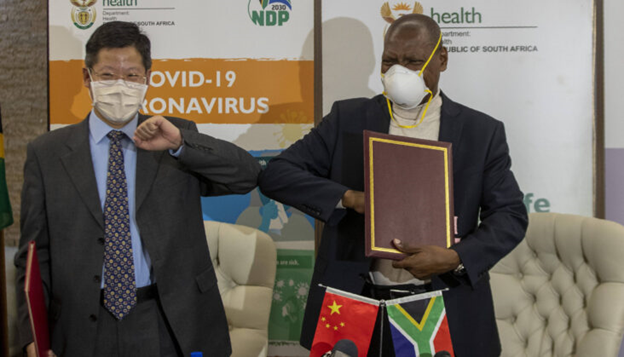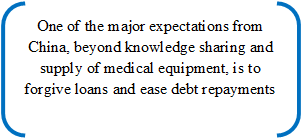Swapneel Thakur, Research Intern, ICS

Since the beginning of the COVID-19 pandemic, China has continued to control the spread of the virus, successfully and effectively. A country of 1.4 billion people, more than the combined the populations of Europe and the United States, has been reporting some clusters of cases and has been able to prevent widespread community transmission. Although much of this success could be attributed to its experience gained from the SARS Epidemic in 2002, China’s disease control strategy featured a balanced combination of both prevention and protection.

Soon after COVID-19 first emerged in December 2019, Chinese scientists were able to identify the virus and share the genome sequencing data internationally. By the end of the January 2020, Chinese doctors had already categorised the clinical symptoms of COVID-19 patients, risks of person to person transmission, genomic characteristics, and the epidemiology. This robust foundation of research was backed by political commitment from the very top to use science to tackle the outbreak decisively. For instance, China’s National Health Commission sent three groups of national infectious disease experts to Wuhan at the beginning of the outbreak to investigate the risks and transmissions of the virus, to which their recommendations for a lockdown immediately implemented. The government was also quick to respond to the advice given by academic scholars such as Cheng Wang, the President of the Chinese Academy of Medical Sciences. His idea of Fangcang shelter hospitals, or temporary hospitals built by converting existing public facilities like stadiums became a key strategy for promptly providing large number of hospital beds and appropriate health care to patients suffering from the disease. However, its prevention control strategy would not have been possible without the broad range of community engagements and solidarity that was seen at an unprecedented level during the COVID-19 outbreak. Control measures that could curb individual freedoms like mandatory wearing of mask in public areas and social distancing were readily accepted by the public, unlike in the Western countries where anti-masking and anti-lockdown protests were quite common. Thus, after achieving the primary objective of limiting the spread of the virus, China’s next strategic goal was to successfully balance these immediate challenges with preventive measures, namely, providing safe and effective vaccines for protecting the population from further infections.

While the US and most Western countries followed a market driven model based on advanced purchase agreements, China adopted a state driven model which leveraged both political mobilisation and the use of economic instruments. Responding to an outbreak of a new infectious disease by solely relying on market mechanism can be expensive, besides being fraught with risks. Furthermore, market-based solutions could increase the probability of slowing down vaccine research due to high levels of uncertainty. For instance, despite having early access to the virus’s genome, several Western pharmaceutical companies continued to dedicate greater share of resources to develop lucrative treatments for existing chronic diseases such as cancer than to counter this infectious disease which could have global ramifications. Janssen and Pfizer’s COVID-19 vaccine research began only when large scale infection was imminent in Western countries during late February.
With vaccine research starting as early as in January 2020, China’s Ministry of Science and Technology (MOST) had already launched emergency research projects by February to accelerate vaccine development. It went on to sponsor five technological roadmaps and 12 vaccine candidates that included private sector giants and nascent start-ups. In order to coordinate policy goals across agencies and to mobilise resources promptly, the government had also established a COVID-19 Task Force comprising senior officials from the National Medical Product Administration (NPMA), the MOST and other concerned departments. The Task Force was affiliated to the Joint Prevention and Control Mechanism of the State Council and reported directly to the Vice Premier of China. Under the Task Force’s direction and guidance, the vaccine research program featured multiple players collaborating to maximise their joint performance. For instance, due to the long-standing relationship that the MOST shared with domestic pharmaceutical companies, the Chinese Government was quickly able to identify enterprises that were capable of developing COVID-19 vaccines during the public health emergency. These enterprises were then supported with efficient allocation of resources required for vaccines development across the Chinese Academy of Sciences, universities, the army and the state-owned enterprises. In addition, the Task Force had also directed the NPMA to modify its procedure in accordance with China’s Vaccine Administration Law to streamline the inspection and review process for vaccines and accelerate market approval.

As of now, four vaccines have been approved in China and in at least one foreign country. Sinopharm’s BBIBP-CorV, Sinovac Biotech’s CoronaVac, CanSino BIO’s Convidecia and ZhifeiLongcom’s ZF2001 make up the most of China and its allies arsenal in the fight to defeat COVID-19. The World Health Organisation (WHO) had also given emergency approval to Sinopharm vaccine in May and the Sinovac Biotech vaccine in June 2021 With the help of government resources and institutions such as Chinese Academy of Sciences and Academy of Military and Medical Sciences, Chinese manufacturers had already started increasing production capacity when the vaccines were in early stage of development. As early as in April 2020,Sinopharm had established production lines in Beijing and Wuhan with an annual capacity of 300 million doses and with plans to eventually export 300 to 500 million doses to over twenty countries. Similarly, Sinovac and CanSinoBIO increased their production capacities to 300 million and 200 million doses respectively. This explains why Chinese companies have been very optimistic about reaching an annual production capacities of more than a billion doses in 2021. For instance, earlier this year both Sinovac and Sinopharm had declared that they were capable of producing more than a billion doses annually. This expanded capacity has allowed China to meet huge domestic demands as well as to fulfil orders from abroad. With Chinese vaccine developers conducting Phase III trials in various countries in Asia, Latin America and Africa, China has emerged as one of the leading suppliers of COVID-19 vaccines in the world.

Such vaccine developers would usually collaborate with local pharmaceutical companies or health departments which helped recruit volunteers, coordinate physical and institutional resources and conduct trials in return for preferential pricing, delivery time and technology transfer. This led to China extending support to more than 80 developing countries. The government has been actively encouraging companies to export independently to other countries in its effort to ensure sufficient supplies of COVID-19 vaccines. Some of the agreements entered into by Chinese companies included an additional clause stating that if a local pharmaceutical company has hosted the clinical trial, the country itself is designated as partner in manufacturing and distributing vaccines for domestic use and export. This explains why China has been supporting overseas production bases of its vaccines in countries like Brazil, UAE, Egypt, Indonesia, Turkey Mexico and Pakistan. While UAE would be producing Sinopharm’s vaccine under the name of Hayat Vax, Brazil, Indonesia, Turkey and Egypt have been manufacturing Sinovac Biotech’s vaccines. Mexico and Pakistan have also started producing CanSinoBIO’s vaccine via an exclusive production line in their respective countries.
As one of the major producers of COVID-19 vaccines in the market, China has reshaped its position as a supplier of affordable vaccines to several developing countries in the world. By investing in research and production capabilities right from the early days of the pandemic, Chinese companies have not only taken major steps to mitigate the severe shortages of vaccines in the developing world but has also provided a viable alternative to expensive vaccines offered by pharmaceutical giants like the Pfizer and Moderna.
The author is thankful to his mentor, Dr. BiswajitDhar, Professor, Centre for Economic Studies and Planning School of Social Sciences, Jawaharlal Nehru University.The views expressed here are those of the author(s), and not necessarily of the mentor or the Institute of Chinese Studies.



